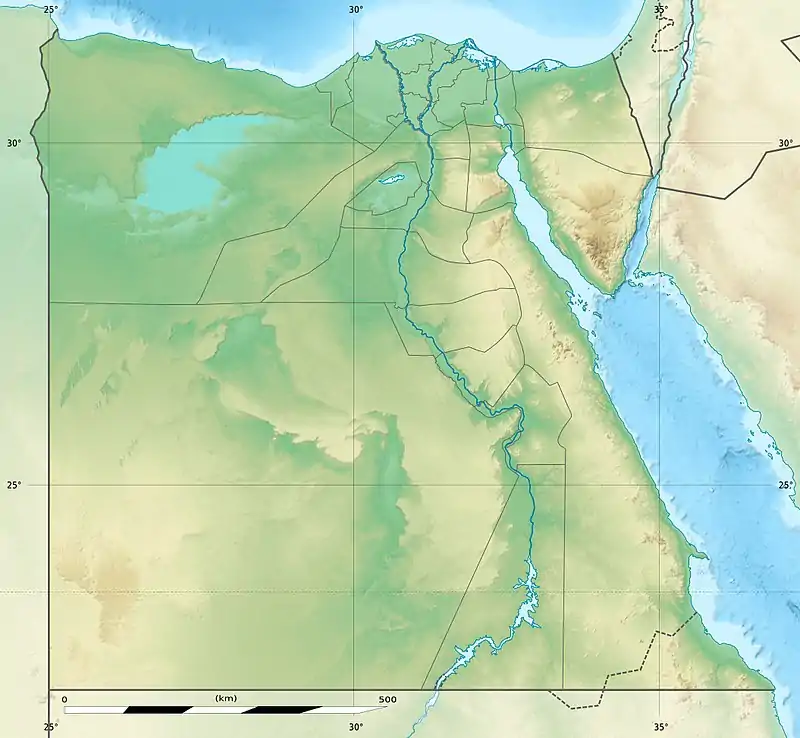Qus
Qus (Arabic: قوص, older name Arabic: قوص واروير, romanized: qus warwir, from Coptic: ⲕⲱⲥ ⲃⲉⲣⲃⲓⲣ)[2][3][4] is a city in the modern Qena Governorate, Egypt, located on the east bank of the Nile.
Qus قوص | |
|---|---|
City | |
 Fatimid tomb at the north-east of the 'Amri mosque at Qus | |
 Qus قوص Location in Egypt | |
| Coordinates: 25°56′N 32°46′E | |
| Country | |
| Governorate | Qena Governorate |
| Area | |
| • Total | 83.1 sq mi (215.1 km2) |
| Population (2021)[1] | |
| • Total | 512,827 |
| • Density | 6,200/sq mi (2,400/km2) |
| Time zone | UTC+2 (EST) |
| • Summer (DST) | +3 |
History
Naming
| gsꜣ or qsꜣ[4] in hieroglyphs | ||||||||||||
|---|---|---|---|---|---|---|---|---|---|---|---|---|
Its modern name is one of many borrowings in Egyptian Arabic from Coptic, the last living phase of Ancient Egyptian. In Graeco-Roman times, it was called Apollonopolis Parva or Apollinopolis Mikra (Greek: Ἀπόλλωνος ἡ μικρά;[5] Ἀπόλλων μικρός),[6] or Apollonos minoris.[7]
During the Roman Empire it was renamed Diocletianopolis; and it corresponds, probably, to the Maximianopolis of the later Empire.
Overview
In the late Old Kingdom and First Intermediate Period, important people of Qus were buried at Naqada at the other side of the Nile. Here were found several stelae belonging to local governors of Qus, including those of Hetepi (priest). Gesa was an important city in the early part of Egyptian history. Because at that time it served as the point of departure for expeditions to the Red Sea. The city gradually lost its importance, only to regain it in the 13th century with the opening of an alternate commercial route to the Red Sea. Since then, Qus replaced Qift as the primary commercial center for trading with Africa, India, and Arabia. It thus became the second most important Islamic city in medieval Egypt, after Cairo.
Today, Qus is the site of a major American/German commercial project to convert the waste products of sugar cane refining (bagasse) into paper products.
The modern population of Qus is around 300,000.
Main sights
Temple of Haroeris and Heqet
The temple of Haroeris (Horus) and Heqet was built during the Ptolemaic Period. Nowadays, only two ruined pylons of the temple remain.[8] It is located at 25°54′57″N 32°45′51″E.
The pylon shows scenes of Ptolemy X Alexander I harpooning hippopotami, presenting offerings to Horus, and offering crowns to both Horus and Heqet. The texts also include the cartouches of Ptolemy IX Soter II(called Lathyros) and his mother Cleopatra III. Near this site a green basalt naos was discovered. It was dedicated to Horus by Ptolemy II Philadelphus. The naos is presumed to have come from the temple as well.[9][Note 1]
Notes
- The numbering of the Ptolemaic rulers can differ in several sources. The numbering used by Porter and Moss seems to be off by 1 compared to Wikipedia. The internal links are based on the second name used. For instance Ptolemy Alexander I is numbered Ptolemy X on Wikipedia, while he is numbered Ptolemy XI in Porter and Moss.
References
- "Qūṣ (Markaz, Egypt) - Population Statistics, Charts, Map and Location". www.citypopulation.de. Retrieved 17 March 2023.
- Černý, Jaroslav (1976). Coptic Etymological Dictionary. Cambridge: Cambridge University Press. p. 345.
- "أسماء بعض البلاد المصرية بالقبطية - كتاب لغتنا القبطية المصرية | St-Takla.org". st-takla.org. Retrieved 2022-10-11.
- Gauthier, Henri (1928). Dictionnaire des Noms Géographiques Contenus dans les Textes Hiéroglyphiques Vol. 5. p. 178.
- Steph. B. s. v.
- Hierocl. p. 731
- It. Anton. p. 158
- Wilkinson, Richard H., The Complete Temples of Ancient Egypt, Thames and Hudson, 2000, pp 152, ISBN 0-500-05100-3
- Porter, Bertha and Moss, Rosalind. Topographical Bibliography of Ancient Egyptian Hieroglyphic Texts, Reliefs and Paintings, V Upper Egypt: Sites (Volume 5). Griffith Institute. 2004.
 This article incorporates text from a publication now in the public domain: Smith, William, ed. (1854–1857). "Apollinopolis". Dictionary of Greek and Roman Geography. London: John Murray. p. 160.
This article incorporates text from a publication now in the public domain: Smith, William, ed. (1854–1857). "Apollinopolis". Dictionary of Greek and Roman Geography. London: John Murray. p. 160.
External links
![]() Media related to Qus at Wikimedia Commons
Media related to Qus at Wikimedia Commons